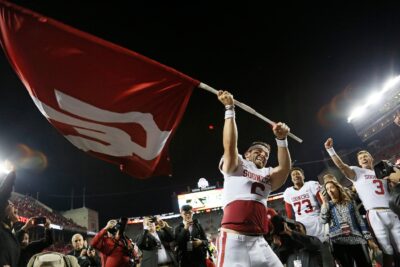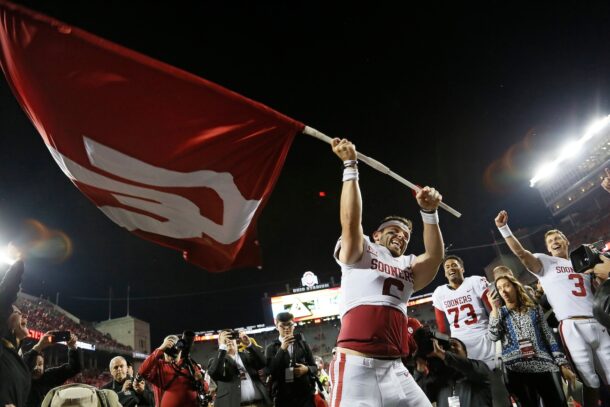Film Study: Jake Coker’s ability to go vertical makes Bama ultra scary
By Murf Baldwin
Published:
The time for graduate transfers to procure a spot on their new team has passed with no sign of Ohio State University quarterback Braxton Miller landing in Tuscaloosa to save the most talented team in college football, the Alabama Crimson Tide, like many widely speculated just a little over a month ago (including myself).
Could it be that former Bama linebacker Trey DePriest was telling the truth when he said that Miller was only in town visiting him, a childhood friend, in between sessions with noted orthopedic surgeon Dr. James Andrews — who is based just a hop, skip and a jump away in Birmingham — and not visiting Bama offensive coordinator Lane Kiffin in some super-secret meeting?
I’ll admit that I, too, became overcome with excitement at the mere thought of the uber-talented signal-caller landing in an offense piloted by Kiffin, with star players the likes of Cam Robinson, Ryan Kelly, Derrick Henry, Kenyan Drake and O.J. Howard.
And that’s glossing over potential superstars Robert Foster, Damien Harris and Calvin Ridley.
To put it simply: Bama is stacked all over the offense. (And defense. And special teams. And…)
But it seems though many in the media have all but counted out the Tide, as it pertains to the bigger picture, because the sentiment coming out of the spring was that they don’t have a championship-caliber QB.
And we all know it’s championship or bust for head coach Nick Saban and his staff.
But doing so is an immense mistake when you have one of the most versatile OC’s in the game who can flip his style from a rhythm-and-timing-based attack to one centered around stretching defenses vertically — which is what he may have to do if fifth-year senior QB Jacob Coker ends up getting the call.
It just so happens the Tide are in possession of just about everything one might need to pull off such a scheme, which could be bad news for those prematurely burying the juggernaut program.
– – – – – – – – – – – –
Now matter how you may feel about Kiffin, there’s no disputing the guy can coach some offensive football.
Letting his weasley personality, or lack of success as a head coach, cloud your judgment on his ability to get the most out of the personnel presented to him is a perfect way to miss just how great he is.
He’s one of a few coaches who infuses a little of each of the major schemes in his philosophy: West Coast, Air Coryell, Erhardt–Perkins, Spread, Option and Wing-T.
Does anyone remember when Bama actually resembled its in-state rival, the Auburn Tigers, behind a hurry-up no-huddle attack centered around the read-option and quick throws out to the edges? (It may have actually been against Auburn, too?!)
That particular style was a sharp contrast to the almost funereal pace the Tide implemented against Louisiana State University and the University of Arkansas.
While Kiffin can undoubtedly re-assert that philosophy into his scheme by starting highly-touted QB Blake Barnett, whose athleticism is only superseded by his ability to work the quick game, it may be in his best interest to allow the frosh some time to grow physically.
To me, this all but leaves Coker as the only way to go for a team desperately needing to stay above the fray in a conference with a ton of teams vying for that No. 1 spot.
Some may point the the presence of redshirt freshman David Cornwell, but I see him being a player more in the mold of Coker opposed to Barnett — so any hint of a tie should go to an upperclassman.
And if so, enter in the Air Coryell portion of the playbook.
Coker’s Uncanny Arm Talent
Let’s get one thing clear: For Alabama to remotely have a shot at the final four, it must do so behind the stylings of Henry, Drake and Harris.
Meaning it’s imperative the run game is the No. 1 priority.
Anytime I think about the vertical-stretch game I harken back to current Minnesota Vikings OC Norv Turner and his time spent in San Diego as the head coach for the Chargers — where QB Philip Rivers (6’5″, 228 lbs) implemented the Air Coryell attack to perfection by threatening defenses with bigger, fast receivers like Vincent Jackson (6’5″, 230 lbs), Malcom Floyd (6’5, 225 lbs) and Antonio Gates (6’4″, 265 lbs).
But even in those days, the most valuable player of the team was always running back LaDainian Tomlinson and his ability to punish defenses in all facets of the game.
In a scheme that forces defenses to defend all areas of the field, it’s the running back that still functioned as the lynchpin of the entire operation.
And the taller receivers acted as bigger downfield targets in a scheme with a ton of low-percentage throws; the further the ball is thrown down the field, the smaller targets appear; why not have bigger targets to circumvent that?
The Tide can replicate this with ease behind Coker’s arm strength, and a gang of bigger receivers: Howard (6’5″, 230 lbs), Foster (6’2″, 194 lbs), ArDarius Stewart (6’1, 204 lbs), Raheem Falkins (6’4″, 210 lbs) and Ridley (6’1″, 170 lbs).
Leaning on the run will force extra attention to the box and open up skinny posts, deep comebacks, deep-digs, corners, seams and clear-outs.
Theoretically, leaning on those type of routes may force the defense to devote extra attention to the back end, which would cause a conflict of assignment.
Just check out this particular sequence with Coker and Foster from the spring game. In what looks like a play right of Turner’s playbook, when he was the OC for the Dallas Cowboys during their dynasty era of the 90’s, Coker was able to hit Foster on this “Bang 8” play which is a skinny post where you hit the receiver in stride.
Case in point…
Here we see Coker’s talents on display on an 8-route of the normal variety where it’s sheer arm strength involved. Notice how Coker doesn’t even drive off his back leg and still gets a ton of velocity and air on the pass.
That was very reminiscent from what we from him in limited duty last season; the guy just has an uncanny ability to stretch the field.
While the quick game has yet to become an aspect where the coaches feel confident in him to operate, a tweak in scheme would undoubtedly open up the underneath stuff as defenses will be scared of Coker hitting the home run.
QB Joe Flacco and the Baltimore Ravens ran this scheme to perfection on their way to a Super Bowl ring just a few short seasons ago. Flacco’s ability to throw the deep ball, which is the very best in the NFL, allowed him the time to polish his quick-game woes as the underneath routes were often met with man coverage.
There’s more than one way to skin a cat in this great game of football. Once the Tide establishes that vertical attack, the rest will fall into place.
It’s ultimately about running the ball and playing suffocating defense, which the Tide will certainly do this season.
Former linebacker/safety Murf Baldwin specializes in diving deep into the Xs and Os of the game with the goal of educating and entertaining while bringing fans closer to their team.











